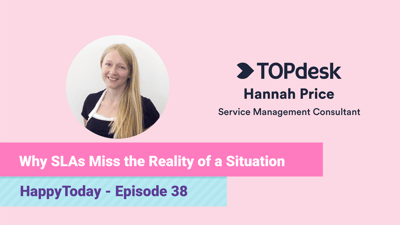When presented with information related to your organization’s need for Experience Level Agreements, you might be left wondering what this relatively new three-letter acronym and how it differs from Service Level Agreements?
We created the Practical Guide to XLAs to help you reach your experience goals, however in this blog post we dive deeper into the key differences between XLAs and SLAs.
Key Definitions:
XLA
|
SLA
|
| XLA is short for eXperience level agreement and can be considered an evolution of, and improvement on, the traditional SLA. |
The AXELOS Service Level Management ITIL 4 Practice Guide defines an SLA as “A documented agreement between a service provider and a customer that identifies both services required and the expected level of service.” |
| There’s no mention of XLAs in 2019’s ITIL Foundation: ITIL 4 Edition publication or the 34 ITIL 4 Practice Guides published in 2020. There is, however, a section on experience, that references XLAs, in the ITIL 4 Managing Professional Drive Stakeholder Value publication. |
Where “The purpose of the service level management practice is to set clear business-based targets for service levels, and to ensure that delivery of services is properly assessed, monitored, and managed against these targets.” |
| Nor are there definitions of experience management and XLAs in the online Information Technology Gartner Glossary (yet). However, Gartner does offer a human resources (HR)-focused definition of employee experience. |
This is echoed by the online Information Technology Gartner Glossary SLA definition: “A service-level agreement (SLA) sets the expectations between the service provider and the customer and describes the products or services to be delivered, the single point of contact for end-user problems, and the metrics by which the effectiveness of the process is monitored and approved.” |
| Importantly, XLAs should be focused on the measurement of outcomes and value of any given service – with the use of experience level targets or experience targets, to monitor and improve outcomes and value, focused on what has been achieved rather than what has been done. |
Although the online Information Technology Gartner Glossary definition for service level management adds in improvement: “The ongoing process of using service-level agreements (SLAs) to maintain high quality in the provision of services — and to ensure that service-level objectives (SLOs) and performance meet the changing needs of the recipient’s business — through continuous improvement of service activities, functions and processes.” |
These definitions give a top line insight into the key definitions, offering an insight into the differences between the two metrics.
As seen above, XLAs are still yet to have an industry defined definition for companies to directly follow. However, this is not a problem, as many definitions of XLAs focus on measuring experience and outcomes, rather than outputs.
But what other differences are between XLAs and SLAs?
Key differences in measurement
HappySignals CEO, Sami Kallio creates a key distinction in measurement between XLAs and SLAs by stating that "“SLAs measure the process, XLAs measure the outcome and value of service.”
XLAs measure something far deeper than SLAs, with the key focus being on experience and the real value you are delivering to your end users. Value doesn't just mean making people more productive and efficient, but it also comes down to happiness through making your end-users' lives easier.
This is something that SLA metrics do not reach, due to a less subjective way of measurement. SLAs focus directly on the outputs of the process and whether certain end results were met; such as time per ticket resolution, costs and budgets. SLAs never show how your end-users are feeling about a service or whether certain IT services are actually negatively impacting their work and productivity.
However, this doesn't dismiss the fact that SLAs should be used. Many of HappySignals' customers will integrate both SLAs and XLAs. But, if you are just using SLAs then you will be missing out on understanding your business needs and how to make your IT organization provide greater value.
The (not so tasty) Watermelon
An analogy and conundrum that will continue to remain prominent in all organizations that fail to integrate experience management. Find out more about the watermelon effect here.
SLAs focus on high level objectives that can be easily met (as mentioned above). However, they do not paint an in-depth picture of what is really happening within IT.
This is a key difference on where XLAs and experience management help change this conundrum. Experience management (measuring and sharing end-user feedback and identifying problem areas), as well as XLAs gather an in-depth insight into how your end-users are experiencing your IT Services.
This gives great and detailed clarification on your end-user pain points and what services needed to be improved to boost productivity. IT is more than just keeping the lights on, but a driving force for business value.
Find out the true success of projects
Your IT projects should not be measured on success by whether or not it has been delivered within the given time frame or budget. The measure success lies with the outcome of the project and whether value has been delivered to the end-user or business.
If you are just measuring if a project was delivered in a budget or right time frame, then what is deemed successful of this? Projects can be delivered in time or under budget, yet have a significant negative impact on end-users experience.
Before every project is started, the outcome should be decided. What do you want to achieve? How can this change add value? How will our end-users benefit from this change?
Static vs Continuous Evolution
In Agile and Devops world, many projects won't have an end, but a continuous cycle of delivering and improving service. Due to constant deliverables and an ever changing end-user experience, it is highly important to have a measurement metric that meets the criteria.
In a nut shell, SLAs will not give you that. SLAs are put in by companies and are hardly ever touched again; shelf-ware. XLAs on the other hand cannot be used in the same ways as SLAs, and is a key mistake people make when trying to integrate the metrics.
As we know, XLAs focus on experience. Experience is an ever changing element, therefore the measurement also needs to evolve in order to effectively measure it.
This leans on the importance of experience management and why you need to have experience management in order to effectively utilise XLAs.
Want to know more about XLAs? Read our Practical Guide to XLAs or even download it and share with your colleagues.



